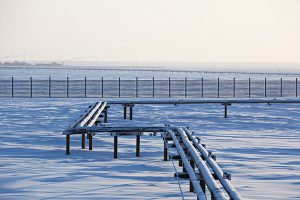Bloomberg
It’s been called a “carbon bomb†and a caribou killer. Now, climate activists have one final, brief window of opportunity to quash ConocoPhillips’s proposed $8 billion oil development in Alaska.
In an unexpected twist, some opponents are quietly encouraging President Joe Biden’s administration to actually approve the project, but in such a scaled-back way that it no long makes economic sense. They’re moving fast, before the Interior Department is set to issue its final ruling in about a month.
This “will be a really important 30 days,†said Abigail Dillen, president of the environmental group Earthjustice.
Foes of the venture see the latest Interior Department analysis as an opening. While the report endorsed a plan to drill wells at three to four locations across the Willow prospect in the National Petroleum Reserve-Alaska, the agency made clear the ultimate decision could take form of an outright denial or an approval with new strings attached.
The Interior Department also made it “crystal clear†that the administration has concerns about the project’s “outsize climate impacts and the impacts to Alaska Natives who rely on subsistence hunting to survive,†Dillen said.
But rather than ask Biden to kill the project altogether, some activists are pushing a plan they think will have more political appeal. If the administration approves a smaller project, that could be seen as a compromise between the president’s climate ambitions and his exhortations for oil industry to crank out more crude to lower energy costs.
In reality, though, ConocoPhillips has already said further reductions to the drilling project would jeopardise the venture. If the government limits drilling to two locations, or well pads, Willow would no longer be economically viable, Erec Isaacson, the president of ConocoPhillips Alaska, told Bloomberg in December.
The Willow venture has been a lightning rod of controversy because of the 614 million barrels of crude and 254 million metric tons of greenhouse gas emissions it could release. Indigenous groups have also said that the project would imperil the health and subsistence lifestyles of Alaska Natives whose cultures and existence depend on the caribou that
migrate through the region.
In its report, the Interior Department’s Bureau of Land Management highlighted a preferred option for project that would be pared down to three well pads, with a fourth indefinitely put off. ConocoPhillips had pursued five.
ConocoPhillips said the three drilling sites “reflect an integrated design concept and provide a viable path forward for development of our leasehold.â€
Some experts say there’s some legal risk to that strategy. It could lead to a run in with federal law that requires the government to fully study the economic and environmental consequences of major decisions.
If the Interior Department were to in the end authorise a two- or even one-well-pad project, it could prompt new construction plans, roadway configurations and other infrastructure, with very different
environmental and economic consequences than government initially analysed.
Leaders from Nuiqsut, Alaska, the village nearest the proposed development, who oppose the project have asked regulators to at least limit activities to a single well pad. That would still allow ConocoPhillips to tap 48% of oil at the site, while minimizing road construction and operations that could disturb the migration patterns of caribou critical to Alaska Natives’ subsistence culture, they said in a letter to federal regulators.
Industry advocates argue that deferring decisions on any more wells would make the project nonviable.
Some regulatory lawyers also say that the administration actually doesn’t have much latitude when it comes to veering from the current proposal, because of Congress’ nearly half-century-old mandate for the government to conduct an “expeditious program of competitive leasing†in the National Petroleum Reserve-Alaska. Although the law doesn’t explicitly force the government to authorise drilling on leases in the reserve, they argue not doing so runs counter to Congress’ intent in compelling oil leasing.
Still, Willow has drawn support from Alaska leaders, labour unions and some Alaska Natives who say it will foster high-paying jobs, deliver much-needed crude and enhance US energy security.
And industry allies are planning to keep the pressure on the administration as well.
However, environmental advocates contend the law also obligates the Interior Department to protect the surface resources of the reserve, and “it can’t do that by allowing new oil drilling when the surface is literally melting away,†said Kristen Monsell, a senior attorney at the Center for Biological Diversity.
 The Gulf Time Newspaper One of the finest business newspapers in the UAE brought to you by our professional writers and editors.
The Gulf Time Newspaper One of the finest business newspapers in the UAE brought to you by our professional writers and editors.
